|
The chart below is for quick reference of the schedules,
prices and contact telephone numbers for the main
sites and monuments. Some monuments do not have contact
information or a schedule as they are outdoors and
can be visited just about any time. You can click
on the link for each monument name in the chart which
will bring you down to a section with more information.
| Monument / Sight |
Schedule |
Price |
Observations |
Archivo
de Indias
(Indian Archives)
|
Mon - Fri: 9:30 - 16:45
Sun, Holidays: 10:00 - 13:45 |
FREE |
- |
Ayuntamiento
(City Hall)
|
Tue - Thu:
1st visit:
17:30
2nd visit:
18:00 |
FREE |
- |
| Casa
de Pilatos |
1 Nov - 31 Mar
Mon - Sun: 9:00 - 18:00
1 Apr - 31 Oct
Mon - Sun: 9:00 - 18:00
|
6 € (Ground floor)
8
€ (Both floors)
|
FREE: Wednesday 15:00-19:00 |
| Casa
de Los Pinelos |
Mon - Fri:
1st visit:
10:30
2nd visit:
11:30
3rd visit:
12:30
|
5€ (Guided tour only)
|
Guided tour only, reservations necesary |
Cathedral &
Giralda |
1 Sep - 30 Jun
Mon - Sat: 11:00 - 17:00
1 Jul - 31 Aug
Mon - Sat: 09:30 - 16:00
Year Round
Sun:
14:30 -18:00 |
8 €
*Students: 2 € |
Includes FREE entrance into the Iglesia Salvador
|
Centro
Andaluz de Arte Contemporáneo
(Modern Art Museum)
|
Tue - Sat: 11:00 - 21:00
Sun: 11:00 - 15:00
Mon: CLOSED |
3 € (all)
1,80 € (exhibits)
(FREE Tue.) |
- |
| City
Walls in Macarena |
- |
FREE |
- |
Costurero
de la Reina
(Queen's Sewing Room)
|
Mon - Fri: 9:00 - 14:00
Sat - Sun: 10:00 - 14:00
|
FREE |
- |
| El
Postigo |
- |
FREE |
- |
Fabrica
de Tabacos
(Tobacco Factory)
|
Mon - Sat: 8:30 - 22:30
|
FREE |
University of Seville |
| Hospital
de la Caridad |
Mon - Sat: 9:00 - 13:00, 15:30
- 19:00
Sun: 9:00 - 12:30 |
5 € |
CLOSED: Some holidays
|
Hospital
de los 5 Llagas
(Parliament Building) |
by appointment only |
FREE |
- |
| Hospital
de los Venerables |
Mon - Sun: 10:00 - 14:00
|
4,75 €
*Students: 2,40 € |
FREE:
Sunday 16:00 - 20:0 |
Iglesia Salvador
(El Salvador Church) |
1 Sep - 30 Jun
Mon - Sat: 11:00 - 17:00
1 Jul - 31 Aug
Mon - Sat: 09:30 - 16:00
Year Round
Sun:
14:30 -18:00 |
*FREE
(see observation to the right) |
FREE when you purchase a ticket to the Cathedral first. |
Italica
(Roman ruins)
|
Tue - Sat: 9:00 -17:30
Sun, Holidays: 10:00 - 16:00 |
1,50 € |
- |
Museo
Arqueológico
(Archaelogical Museum)
|
Tue - Sat: 9:00 - 20:30
Sun: 9:00 - 14:30
Mon: CLOSED |
1,50 €
*Students: FREE |
- |
Museo
de Artes y Costumbres
(Museum of Popular Customs)
|
Tue - Sat: 9:00 - 20:30
Sun: 9:00 - 14:30
Mon: CLOSED |
1,50 €
*Students: FREE |
- |
Museo
de Bellas Artes
(Museum of Fine Art)
|
Tue - Sat: 9:00 - 20:30
Sun: 9:00 - 14:30
Mon: CLOSED |
1,50 €
*Students: FREE |
- |
Museo
del Baile Flamenco
(Flamenco Dance Museum)
|
Mon - Sun: 9:30 - 19:00
|
10 €
*Students: 8 € |
- |
Museo Naval
(Naval Museum in Torre del Oro) |
Tue - Fri: 10:00 - 14:00
Sat - Sun: 11:00 - 14:00
Mon, Month of August: CLOSED |
2 €
*Students: 1 € |
FREE: Tuesdays |
Museo
(Roman mosaics, more in Palacio
de Lebrija) |
1 Sep - 30 Jun
Mon - Fri: 10:30 - 19:30
Sat: 10:00 - 14:00, 16:00 - 18:00
Sun: 10:00 - 14:00
1 Jul - 31 Aug
Mon - Fri: 9:00 - 15:00
Sat: 10:00- 14:00
Sun: CLOSED |
3,60 - 6,60 € |
-
|
Museo
de Carrujaes
(Carriage Museum)
|
16 Sep - 15 Jun
Mon - Fri: 9:00 - 14:00, 16:30 - 19:30
16 Jun - 15 Sep
Mon - Fri: 9:00 - 14:00
Sat, Sun, Month of August: CLOSED |
3,60 €
*Students: 2,40 € |
- |
Museo
Militar Regional
(Military Museum)
|
Tue - Fri: 9:30 - 13:30
Sat: 10:00 - 14:00
Sun, Mon: CLOSED |
FREE |
- |
Museo de la Tolerancia
(Musem of Tolerance in Castillo San Jorge)
|
Mon - Fri: 9:00 - 14:00
Sat - Sun: 10:00 - 14:00 |
FREE |
Below Triana Market |
Museo Antiquarium
(Archealogical Museum below Plaza Encarnacion) |
Mon - Sat: 11:00 - 14:00, 15:00 - 20:00
Sun: CLOSED |
2 €
*Students: FREE |
Below Plaza Encarnacion Market |
| |
|
|
|
Palacio
de Arzobispo
(Archbishop's Palace)
|
not open to public |
n/a |
- |
Palacio
de Lebrija
(Palace)
|
1 Sep - 30 Jun
Mon - Fri: 10:30 - 19:30
Sat: 10:00 - 14:00, 16:00 - 18:00
Sun: 10:00 - 14:00
1 Jul - 31 Aug
Mon - Fri: 9:00 - 15:00
Sat: 10:00- 14:00
Sun: CLOSED |
3,60 - 6,60 € |
-
|
Palacio
de San Telmo
(Palace)
|
Mon - Thu: 9:00 - 19:00
Fri: 9:00 - 15:00 |
FREE |
Guided visits only, appointment necessary |
| Plaza
de España |
Mon - Fri: 9:00 - 22:00 |
FREE |
Open air in Parque Maria Luisa |
Plaza
de Toros
(Bullring)
|
1 Nov - 30 Apr
Mon - Sun: 9:30 - 19:00
1 May - 31 Oct
Mon - Sun: 9:30 - 19:00 |
6,50 €
*Students: 4 € |
On days with bullfights it closes at 15:00 or 2 hours before the event |
Reales
Alcazares
(Royal Palace)
|
1 Apr - 30 Sep
Mon - Sun: 9:30 - 19:00
1 Oct - 31 Mar
Mon - Sun: 9:30 - 17:00 |
7,50 €
*Students: FREE |
- |
| Reales
Atarazanas |
Winter
Tue - Sun: 9:30 - 14:30, 16:00
- 18:00
Summer
Tue - Sun: 9:30 - 14:30, 19:00
- 21:00 |
FREE |
- |
Torre
del Oro
(Golden Tower)
|
Tue - Fri: 10:00 - 14:00
Sat - Sun: 11:00 - 14:00
Mon, Month of August: CLOSED |
2 €
*Students: 1 € |
FREE: Tuesdays |

 : : |
Avda. Constitución (Santa
Cruz) |
 : : |
954 214 971 |
 : : |
www.catedralsevilla.org |
 : : |
7 € |

Sep - Jun: |
Mon - Sat 11:00 - 17:00 |
| Sun 14:30 -18:00 (FREE) |

Jul - Aug: |
Mon - Sat 9:30 - 15:30 |
| Sun 14:30 -18:00 (FREE) |
 Photo
tour of the outside Photo
tour of the outside
 Photo
tour of the inside Photo
tour of the inside
The third largest cathedral in the world, behind
only St. Peters in Rome and St. Paul's in England.
The Cathedral does hold the record as the largest
gothic building in the world, which you're sure to
see when visiting. This is the most visited
site in Seville. Construction began in 1401 on the
grounds of the center mosque constructed during Arab
occupation. The Patio de Naranjos and the main section of the Giralda are the only structures
remaining from the mosque. The climb up the Giralda,
approximately 70 meters, is made easier with the absence
of stairs. Instead a series of ramps leads you to
the top for a perfect view of the city. Inside are
works of by Murillo, Goya, Pedro de Campaña
and Luis de Vargas. Sculpture includes works by Martinez
Montañés. The tomb of Columbus is said
to be located here as well, a disputed claim which
may soon be known as fact when the FBI finishes DNA
analysis of the remains.
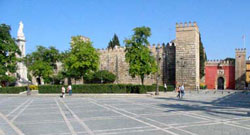
 : : |
Patio de Banderas s/n |
 : : |
954 502 323 |
 : : |
patronato-alcazarsevilla.es |
 : : |
5 € |

Oct - Mar: |
Tue - Sat: 9:30 - 17:00 |
| Sun, Holidays: 9:30 - 13:30 |

Apr - Sep: |
Tue - Sat: 9:30 - 19:00 |
| Sun, Holidays: 9:30 - 17:00 |
 Photo
tour Photo
tour
Located between the Jardines de Murillo and the Cathedral,
the Alcazar or Royal Palace in Seville is
still a vacation spot for the King and Queen. Construction
first began under Abd Al Ramán III in the early
10th century it is one of the best examples of mudéjar architecture in all of Spain. Later additions included
those by Pedro the Cruel with the aid of Moorish craftsmen.
The grounds and gardens around the building are an
important part of the visit. If you're not able to
make it to Granada to see the Alhambra make sure you
stop here.
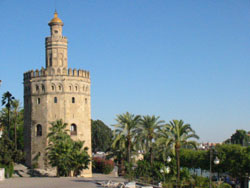
 : : |
Paseo Colon (Arenal) |
 : : |
954 222 419 |
 : : |
1 € (Tuesday Free) |
 : : |
Tue - Fri: 10:00 - 14:00 |
| Sat, Sun, Holidays: 11:00 - 14:00 |
Located on the Guadalquivir River and dating back
to the 13th century (Almohade period), the top of
the Torre del Oro was once covered in gold tiles which
reflected in the sunlight, making the tower a visible
fixture in Seville. During the Arab occupation it
served as main point of defense and control of the
river. The tower was connected to the city walls,
and a large linked chain ran from the building to
the other side of the river to control maritime traffic
into the city. The Torre del Oro now houses the local
maritime museum.
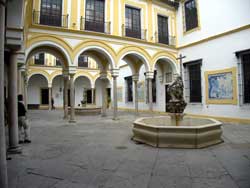
 : : |
C/ Temprado, 3 (Arenal) |
 : : |
954 223 232 |
 : : |
santa-caridad.org |
 : : |
4 € |
 : : |
Mon - Sat: 9:00 - 13:30; 15:30 -
19:30 |
| Sun, Holidays: 9:00 - 13:00 |
The church dates back to the 17th century and the
building still serves it's purpose as a refuge for
the ill and less fortunate. The house was provided
by the wife of don Miguel de Mañara, a wealthy
Sevillano, after his death. Works inside include two
paintings from Juan de Valdés Leal as well
as the intricate altarpiece work by Pedro Roldán.
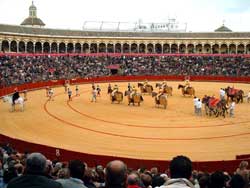
 : : |
Paseo Colon (Arenal) |
 : : |
954 224 577 |
 : : |
realmaestranza.com |
 : : |
4 € |
 : : |
Mon - Sun 9:30 - 19:00 |
| Bullfights: 9:30 - 15:00 |
 Photo
tour Photo
tour
The Plaza de Toros was constructed over several decades
during the 18th century and is one of the most famous
venues in all of Spain to take in a bullfight. The
season typically begins with the Feria de Abril, during which there is a corrida every
day, and runs through September. When buying tickets
take your choice of sol (cheaper), sombra (expensive) and sol y sombra (middle
range) seats. The museum includes statues of famous
bullfighters, posters and other memorabilia as well
as a gift shop.
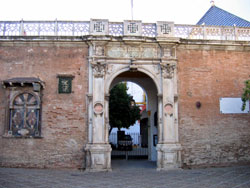
 : : |
Plaza Pilatos - C/ San Esteban (Puerta
Carmona) |
 : : |
954 225 298 |
 : : |
5 € lower floor, 8 € complete tour |
 : : |
Mon - Sun: 9:00 - 18:00 |
| Tue: 13:00 - 17:00 Free. |
Currently owned by the Dukes of Medinaceli, the palace
was built in the 16th century by a wealth aristocrat
after returning from a voyage to Jerusalem. The architectural
styles of Baroque, Renaissance and Mudéjar
blend together almost seamlessly. The complete tour
includes the upstairs rooms with an impressive collection
of Roman antiquities. And in keeping with the architectural
styles, Baroque and Renaissance paintings. Tuesdays
between 13:00 - 17:00 is free entrance for EU citizens,
but they often waive anyone through.

 : : |
Avda. de Extremadura, 2 (Santiponce) |
 : : |
955 996 583 |
 : : |
Town
of Santiponce Italica Site |
 : : |
1.50 € (FREE for E.U. citizens) |
 : : |
Tue - Sat: 9:00 -17:30 |
| Sun, Holidays 10:00 - 16:00 |
Birthplace of Roman emperors Trajan and Adrian, Italica
is a 15 minute bus ride from Seville in the pueblo
of Santiponce. The amphitheater is the most important
site of the ruins. You're also able to walk the old
streets as you tour the ruins of houses, public buildings
and various objects of art. Many of the pieces can
now be found in the Museo Arqueológico or within
the palaces and homes of the aristocracy in Seville.
Columns supporting the Giralda were also taken from
the ruins of Italica.
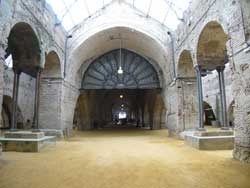
 : : |
C/ Temprado (Arenal) |
 : : |
954 218 696 |
 : : |
FREE (except events and exhibits) |
 : : |
Tue - Sat 10:00 - 14:00, 16:00 - 18:00 |
| Sun 10:00 - 13:00 |
Located next door to the Hospital de La Caridad the
Royal Shipyards used to house munitions and artillery
for the Spanish Navy. Inside it's fairly empty except
for a few exhibits and explanations in the back. Worth
a stop when next door at the Hospital de la Caridad,
and the rows and rows of arches make for some good
pictures. Concerts and special exhibits are often
held in in the building, and at times are free.
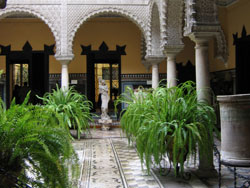
 : : |
C/ Cuna (Center - Shopping district) |
 : : |
954 21 81 83 / 954 22 78 02 |
 : : |
palaciodelebrija.com |
 : : |
3,60€ lower floor, 6,60€ complete
tour |
 : : |
Mon - Fri: 10:30 - 14:00, 17:00 - 19:00 |
| Sat: 10:00 - 13:00 |
 Photo
tour Photo
tour
Located in the shopping district on calle Cuna, the
Palacio de Lebrija is a 16th century palace which
holds a very impressive collection of Roman mosaics
from the nearby ruins of Italica. It is one of the
few places in the world where you can actually walk
on top of some of the mosaics, just as the Romans
did! The excellent condition of the house is due to
the extensive renovation work of Doña Regla
Manjón Mergelina, the Countess of Lebrija in
the early 20th century. She was a world traveler as
well as a dedicated collector as the house indicates
in it's displays of pieces from as far away as Mexico
and the far east. Other sections of the house such
as portions of the ceiling and a mahogany banister
come from nearby churches and palaces in Andalucia.
Thanks to her work many of the Roman mosaics discovered
around Italica have been preserved.
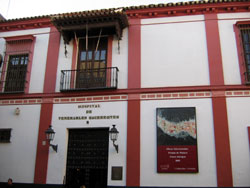
 : : |
Plaza de los Venerables |
 : : |
954 562 696 |
 : : |
focus.abengoa.es |
 : : |
4,75€ (Sundays 16:00 - 20:00 FREE) |
 : : |
Mon - Sun: 10:00 - 14:00, 16:00 - 20:00 |
Located in the heart of Santa Cruz, construction
of the building began during the early baroque period
in Seville in 1676. Begun by architect Juan Domínguez,
it was eventually completed in 1697 by Leonardo de
Figueroa. The most impressive part is the church.
entirely painted - walls and roof - with figures by
Valdés Leal (and his son Lucas Valdés).
Sculptures of St. Peter and St. Ferdinand by Pedro
Roldán are at the foot of the nave beneath
the choir, as well as altarpieces by Juan de Oviedo,
and the pulpit of wood and marble by Francisco de
Barahona. This is a nice Sunday afternoon visit when
the entrance is free.
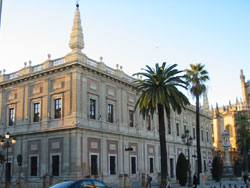
 : : |
Avda. Constitución s/n |
 : : |
954 500 530 / 954 500 528 |
 : : |
Ministerio
de Cultura Official Page |
 : : |
FREE |
 : : |
Mon - Fri: 8:00 - 15:00 (researchers) |
Located in the heart of Santa Cruz, construction
of the building began during the early baroque period
in Seville in 1676. Begun by architect Juan Domínguez,
it was eventually completed in 1697 by Leonardo de
Figueroa. The most impressive part is the church.
entirely painted - walls and roof - with figures by
Valdés Leal (and his son Lucas Valdés).
Sculptures of St. Peter and St. Ferdinand by Pedro
Roldán are at the foot of the nave beneath
the choir, as well as altarpieces by Juan de Oviedo,
and the pulpit of wood and marble by Francisco de
Barahona. This is a nice Sunday afternoon visit when
the entrance is free.
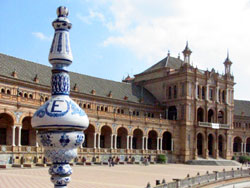
 : : |
Parque Maria Luisa, Avda Isabela
la Católica, s/n |
 : : |
FREE |
Located on the edge of Parque Maria Luisa, the Plaza
de España was designed and constructed under
the direction of Anibal Gonzalez, perhaps Seville's
best known architect, for the 1929 Ibero-American
Expo. Now used as government offices and still undergoing
renovations, it is a pleasant visit during the day
and at night to see the fountain illuminated. Wandering
around the semi-circular grounds it is interesting
to take in the paintings over ceramic tiles, representing
an historical event in each province of Spain. And
children will of course recognize the backdrop as
being featured in one of the latest Star Wars movies.
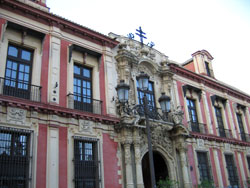
 : : |
Plaza Santa Marta |
 : : |
Not open to the public |
 : : |
Not open to the public |
Located at the foot of the Giralda tower in the center
of the historic district. The Archbishop's Palace
is an 18th century casa-palacio which is
home to the Sevillian clergy and Archbishop Carlos
Amigo. While you can only get a glimpse of the patio
from the main gate, if you were to venture further
inside you would see important works by Murillo and
other painters. If you hang around long enough you
may even get to see Carlos Amigo as he leaves for
an afternoon stroll. I always like to think he's heading
for a beer and tapas at Las Columnas.
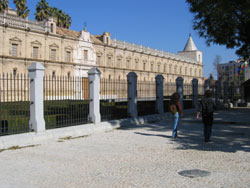
 : : |
C/ Parlamento de Andalucía
s/n
(opposite the Macarena Church) |
 : : |
954 592 288 / 954 592 100 |
 : : |
parlamento-and.es |
 : : |
FREE |
 : : |
by appointment only; More
info |
| February 28th - open to public |
Located just outside the old city walls and opposite
the Macarena Church, the Hospital de las 5 Llagas
was in ruins some 15 years ago. Now completely renovated
with a nice open garden in front, this Renaissance
building constructed in the 16th century is now the
home of the Andalusian Parliament. For general entrance
it is open to the public only two days per year, surrounding
February 28th and the official holiday of Andalucia
Day (Día de Andalucia). Otherwise appointments
can be made for groups or individuals in advance by
calling ahead for the details. More information for
visits can also be found on this
page.
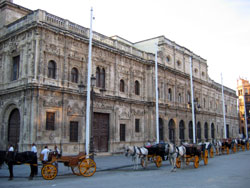
 : : |
Plaza Nueva |
 : : |
954 590 101 |
 : : |
sevilla.org |
 : : |
FREE |
 : : |
Tue - Thu: 17:30 - 18:00 |
Located in the very center of Seville between Plaza
Nueva and Plaza San Francisco, the Ayuntamiento, or
Town Hall, separates the historic and shopping districts
in Seville. The 19th century
renovation was the work of architects Demetrio de
los Ríos and Balbino Marrón. This later renovation can be seen from the side of
Plaza Nueva and is an excellent example of neo-classical
design. The side often featured in guide books and
photos is facing Plaza San Francisco and is a wonderful
example of Renaissance architecture. This side of
the building was the work of Diego de Riaño
in the 16th century, who used an ornate style to depict
the two mythic characters Hercules and Caesar, who
as legend has it founded the city of Seville. The
front steps of the Ayuntamiento (on the Plaza Nueva
side) are also a popular meeting place for locals!
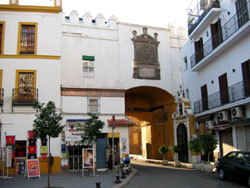
 : : |
C/ Almirantazgo |
 : : |
FREE |
Located in the Arenal neighborhood and known simply
as "El Postigo" to most sevillanos, the
gate of the old city walls was once known as "El
Positgo del Aceite". It was through this gate
that shipments of oil from the river entered into
the city. The original gate date back to the time
of Ben Yusuf, but was later renovated in the 16th
century by architect Benvenuto Tortello. The work
of Pedro Roldán can be seen in the very small
18th century chapel just next to the arch featuring
his baroque style altar piece.
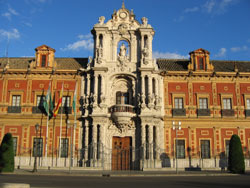
 : : |
Avda. de Roma, s/n |
 : : |
955 035 558 |
 : : |
juntadeandalucia.es |
 : : |
FREE |
 : : |
by appointment only |
Located just outside the Puerta Jerez behind the
Hotel Alfonso XIII, The Palacio de San Telmo was first
commissioned as a university in 1685. Undergoing several
changes in purpose, from Naval College to residence
of a noble family, the Palacio de San Telmo, like
so many others, is now home to government offices
and the presidency of the Andalusian Parliament. When
renovated by the Dukes of Montpensier, the northern
facade of the building was erected complete with statues
of famous figures in Sevillian history. We have been
informed that the visits, by appointment only, have
now been suspended for several years as renovations
will be underway soon.

 : : |
C/ San Fernando s/n |
 : : |
954 551 000 |
 : : |
us.es |
 : : |
FREE |
 : : |
Mon - Sat: 8:30 - 22:30 |
Located next door to Hotel Alfonso XIII and the Puerta
Jerez, the Real Fabrica de Tabacos is now the main
building for the University of Seville. Built over
50 years in the 18th century, the original purpose
was the production of tobacco products from the New
World, and was made famous by the Bizet's opera Carmen.
At one time this was the largest industrial building
in all of Europe, complete with moats, a chapel, jailhouse
and several courtyards and fountains. It is very accessible,
and anyone can walk through the building and around
the grounds, with no appointment or entrance fee.
When open the small University Chapel is also a nice
visit, featuring the image of Cristo de la Buena Muerte,
a work by the famous Sevillian sculptor Juan de Mesa.
If you are looking for cheap food and drinks the two
cafeterias inside offer prices perfect for the student
budget.
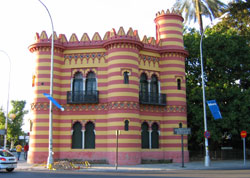
 : : |
Paseo de las Delicias, 9 |
 : : |
|
 : : |
|
 : : |
FREE |
 : : |
Mon - Fri: 10:00 - 14:00, 16:00 - 20:00 |
Bordering Maria Luisa Park and just opposite the
river on Paseo de las Delicias is the Queen's Sewing
Room, now a tourist office. Recently renovated it
is perhaps the most inconvenient location of all the
tourist offices, but the most historically significant.
The name comes from it's use by Maria de las Mercedes,
the queen who was ill and used the site as a refuge
to sew or enjoy the open air close to the river.
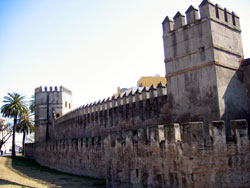
 : : |
C/ Muñoz León |
 : : |
FREE |
Located throughout the city the best examples of
the walls can be found just next to the Macarena Church.
Here a large section has been preserved, complete
with lighting at night which was recently added. The
city walls have a long history, dating back to Roman
times. It was the during the Almoravide period that
the walls saw their greatest expansion and fortifications.
At one time Seville was completely enclosed with the
walls connecting to the Torre del Oro, the principal
defensive position along the Guadalquivir River. A
series of 19 gates to the city were erected, often
named for their purpose (entrance or exit to a neighboring
town or city - Carmona, Cordoba - or a specific product
- meat, oil, trash!) The last standing gate is that
of the Macarena, just out of the picture to the right
of the tower in the photo above.

 : : |
Plaza del Salvador s/n |
 : : |
954 211 679 |
 : : |
colegialsalvador.org |
 : : |
2€ donation |
 : : |
Sat, Sun: 10:00 - 14:00, 16:00 - 20:00 |
Located just around the corner from the main shopping
streets of Sierpes and Tetuan, the El Salvador Church
was once the site of the largest mosque in Seville,
erected under the leader Abd al Rahman II, or Idn-
Addabas. The only remains of the mosque on the site
of El Salvador are the Patio de Naranjos, or Orange
Tree Patio which is still partially preserved. The
mosque was later relegated to second place with the
construction of the newer and much larger mosque at
the site of Seville's Cathedral. El Salvador is Seville's
second largest church and an excellent example of
baroque architecture. Constructed between the late
17th and early 18th centuries, many artists have contributed
to the design and works inside, including: Cayetano
de Acosta, Juan de Mesa and Martínez Montañés.
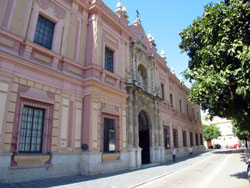
 : : |
Plaza del Museo (Center) |
 : : |
954 220 790 |
 : : |
juntadeandalucia.es/cultura/ |
 : : |
1.50€ (FREE w/student ID; E.U. citizens) |
 : : |
Tue: 14:30 - 20:30
Wed - Sat: 9:00 - 20:30 |
| Sun, Holidays 9:00 -14:30 |
Opened in the middle of the 19th century as a Museo
de Pinturas, the museum mostly featured works
from convents and churches. (The original building
was a convent: Convento de la Merced). After
several renovations in the 18th, 19th and 20th centuries
the museum is completely renovated and now well-known
for it's paintings dating from the 15th to 17th centuries
of the Seville School. Works by Murillo, Zurbarán,
and Valdés Leal are the most representative
of the collection. Said to be the second best art
museum in Spain behind only the Prado in Madrid, although
I think this could be said of many art museums throughout
Spain.
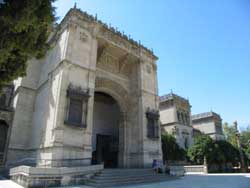
 : : |
Plaza de America (Parque M. Luisa) |
 : : |
954 232 401 |
 : : |
juntadeandalucia.es/cultura |
 : : |
1.50€ (FREE for E.U. citizens) |
 : : |
Tue: 14:30 - 20:30
Wed - Sat: 9:00 - 20:30 |
| Sun, Holidays 9:00 -14:30 |
The Archaeological Museum is located in what was
the Renaissance Pavilion for the 1929 Expo, and the
work of Sevillian architect Anibál González.
In the 1940's the archaeological collection of the
Seville province was moved to the building. The Museum
has some 27 exhibition rooms and includes pieces from
the nearby Roman settlement of Italica. Pieces represent
the diverse culture, people and history of Andalucia,
including items from Tartessan civilization and much
further back to prehistoric times. Exhibits and pieces
cover the times from the 8th century B.C. to the 15th
century.
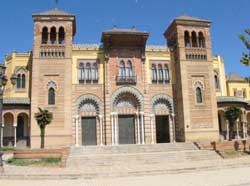
 : : |
Plaza de America (Parque M. Luisa) |
 : : |
954 232 576 |
 : : |
juntadeandalucia.es/cultura |
 : : |
1.50€ (FREE for E.U. citizens) |
 : : |
Tue: 3pm-8pm,
Wed - Sat: 9am-8pm |
| Sun, Holidays 9am-2pm |
Across from the Archeological Museum in Parque Maria
Luisa, the Museum of Arts and Customs contains an
impressive collection of decorative arts and traditional
dress/clothing. Like it's counterpart, the museum
was once the Mudejar Pavilion designed and constructed
by Anibál González for the 1929 Expo.
Objects from everyday life - Dresses and jewels, Clothes
and customs of celebrations, musical instruments,
agriculture, gold work, weaving, embroidery, ceramics,
furnishings and other artisan and industrial activities.
There is also an exhibition of Feria posters from
over the years. The museum also has several exhibition
rooms with works from the Gothic age to the 20th century.
Interestingly enough the city recently turned down
a bid from a large hotel chain to turn this into a
luxury hotel. Thankfully culture prevailed over the
Euro.
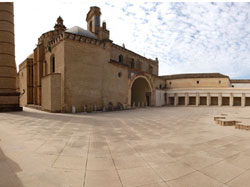
 : : |
Avda. Américo Vespucio, 2 |
 : : |
954 225 084 / 955 037 070 |
 : : |
caac.es |
 : : |
3€ (all) 1,80€ (exhibits) (FREE
Tue.) |

Oct - Mar: |
Tue - Fri: 10:00 - 20:00
Sat: 11:00 - 20:00 |
| Sun, Holidays: 10:00 - 15:00 |

Apr - Sep: |
Tue - Fri: 10:00 - 21:00
Sat: 11:00 - 21:00 |
| Sun, Holidays: 10:00 - 15:00 |
Located in la Cartuja de Santa Maria de Las Cuevas,
the Modern Art Museums is dedicated to temporary exhibits
of contemporary works, such as painting, sculpture,
tapestry, ceramics and more. There are also several
permanent exhibits, plus special performances such
as dance, music, etc.
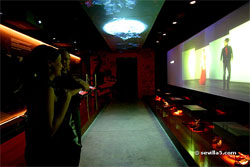
 : : |
C/ Manuel Rojas Marcos, 3 |
 : : |
954 340 311 |
 : : |
museoflamenco.com |
 : : |
10€ (adults) 6€ (children) |

Nov - Mar: |
Mon - Sun: 9:00 - 18:00 |

Apr - Oct: |
Mon - Sun: 9:00 - 19:00 |
The Museum of Flamenco Dance, the only one of its kind in the world, takes you on a journey to the heart of the Andalusian people, their identity and their spirit. This interactive museum is where the deepest roots of flamenco and the latest multimedia technology come together. The museum is an obligatory visit for anyone who wishes to gain an insight into the culture of Andalusia.
|